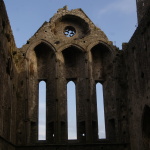There are 186 cathedrals in France, and about 4000 smaller churches, not counting the ones that are mere jagged ruins along the highways. From Chartres and Notre Dame of Paris to squat, plain-fronted little chapels in Alsatian wine villages, they are weighted with a dim, sooty sense of history that is lacking in our red-brick American churches with their modern circular naves and abstract strained glass. What they lack is the bustle of American churches. Other than during Mass times, a French church will probably be empty of anyone except a few grandmothers and ragged men on their knees – and, of course, tourists. Only about 12% of French citizens report attending Mass weekly. The big cathedrals in cities like Paris and Strasbourg are immaculately maintained by the state as cultural treasures, but the little churches in country towns suffer from leaky roofs, rusting iron statues – and empty pews.
And you can hardly turn around in Ireland without encountering the skeleton of an abandoned church or monastery. Most of that is the result of Ireland’s unfortunate history, of course. First the Anglo-Normans closed the Celtic Christian monasteries and imposed their own hierarchical, rule-bound version of Catholicism on Ireland. Then Henry VIII closed the Anglo-Norman monasteries, and finally Cromwell’s armies came along and burned any Catholic church that was in their path (with the people still in them, on at least one occasion). Most of those skeletons have been slowly crumbling for a long time. Still, there is no escaping the stark fact that church attendance even in devout Ireland, though still among the highest in Western Europe, fell from about 85% to 60% between 1975 and 2004.
I couldn’t help wondering what that means. In my novel The Saint’s Mistress, I dealt with the many reasons for the rise of the Christian church in Europe, from its ability to fill the power vacuum left by the collapse of the Roman Empire, to the attraction for women of a religious authority that frowned on abortion and infanticide and made a mission of caring for the poor, the sick and the widowed. My own belief is that the fundamental reason for the rise of Christianity is that it is true.
But what does that then say about its decline in the West?
I was disturbed by the thought that Europe, at least, seems to be living in a post-Christian era. We live now in the era of Google and Apple and Nike and General Electric. The West has gained so much in the past 200 years, but I wondered about what we have lost. Does God still live at all in the beautiful places that people built in our striving towards Him? Does He live in those crumbling, abandoned little country churches in France? What does it mean that our ancestors invested in cathedrals and we invest in office buildings and resort spas and 6000-square foot McMansions?
Part of the answer came in a surprising place: a 14th-century church in Galway, Ireland, where I expected to find only history. To be continued…..

